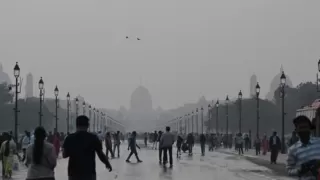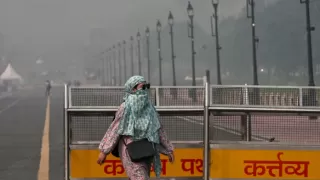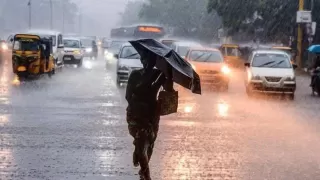Delhi is on the verge of a scientific breakthrough in pollution control as the city prepares for its first-ever artificial rain through cloud seeding. The initiative, led by IIT Kanpur in partnership with the Delhi government, seeks to tackle rising particulate pollution levels in the national capital. Chief Minister Rekha Gupta confirmed that a successful trial was conducted earlier in the Burari area, marking a historic milestone in Delhi's fight against smog and air pollution.
The government hopes the artificial rain program will not only improve air quality but also serve as a model for other major cities struggling with winter smog. With favorable weather conditions expected between October 28 and 30, the first official cloud seeding operation is likely to take place on October 29, provided the atmospheric conditions remain conducive.
Successful Trial at Burari
The trial flight, which marked the first experimental run for artificial rain in Delhi, was conducted from IIT Kanpur to Delhi via Meerut, Khekra, Burari, Sadakpur, Bhojpur, Aligarh, and back. Cloud seeding flares were fired between Khekra and Burari and over the Badli area using pyro techniques, testing the aircraft's capabilities and the effectiveness of the cloud-seeding system.
Environment Minister Manjinder Singh Sirsa highlighted that the trial was also aimed at evaluating aircraft endurance, the coordination of multiple agencies, and real-time execution of cloud-seeding protocols. The insights gained from this exercise will guide upcoming operations and help fine-tune the technology for maximum efficiency.
Scientific Goals of the Initiative
The cloud-seeding project is designed to reduce particulate matter in Delhi's air by inducing rainfall artificially. IIT Kanpur, in collaboration with experts from the Indian Institute of Tropical Meteorology (IITM), Pune, and the India Meteorological Department (IMD), has developed sophisticated methodologies for targeting clouds and dispersing seeding materials to stimulate precipitation.
This initiative is not only technologically innovative but also provides a scientific basis for air quality management. By combining meteorological data, aircraft operations, and cloud physics, authorities aim to create a controlled method to reduce pollution peaks during the winter months.
Government Oversight and Authorizations
The project has received authorization under rule 26(2) of the Aircraft Rules, 1937, allowing IIT Kanpur to deploy a Cessna 206-H aircraft (VT-IIT) for cloud-seeding operations. Approval was granted by 23 government departments, including the Directorate General of Civil Aviation (DGCA), ensuring strict compliance with safety, security, and air traffic regulations.
Five cloud-seeding trials have been scheduled, focusing primarily on northwest Delhi, where pollution levels tend to peak during winter. Each operation will follow meticulously planned protocols, including coordination with air traffic authorities and continuous monitoring of weather conditions by the IMD.
Environmental and Public Health Impact
Delhi suffers from high levels of particulate pollution every winter, resulting in severe health issues such as respiratory and cardiovascular diseases. Artificial rain through cloud seeding could help mitigate these effects by washing pollutants from the air, thereby improving air quality and reducing health risks.
Experts believe that if the program is successful, it could become a recurring strategy during the winter months, supplementing existing pollution-control measures such as vehicular restrictions, industrial emission controls, and public awareness campaigns.
Technological Challenges and Solutions
Cloud seeding is a complex process that depends on the right atmospheric conditions, including cloud density, humidity, and temperature. IIT Kanpur has developed protocols to ensure that seeding occurs under optimal conditions to maximize rainfall while minimizing environmental risks.
The aircraft used for the operations is equipped with specialized flares containing seeding materials. Pilots and scientists work in tandem to target specific cloud formations, with real-time adjustments made based on meteorological readings and satellite imagery.
Community and Public Engagement
The Delhi government has emphasized transparency and public engagement, using media updates and social media posts to inform citizens about the project. Residents are encouraged to monitor weather reports and stay informed about upcoming cloud-seeding operations.
Public awareness campaigns also highlight the importance of combining technological solutions with everyday actions, such as reducing emissions, to achieve a cleaner, healthier environment in the capital.
Future Prospects and Expansion
If the pilot program proves effective, Delhi plans to expand cloud-seeding operations to other high-pollution areas of the city. The government is also exploring partnerships with additional research institutions to refine the technology, increase operational efficiency, and potentially develop similar programs in other polluted urban centers across India.
Long-term goals include establishing a scientific framework for artificial rain as a sustainable pollution-control measure and integrating it into broader urban environmental management policies.
Conclusion
Delhi’s artificial rain initiative represents a historic convergence of technology, science, and governance aimed at tackling one of the city’s most pressing challenges. With the successful Burari trial and official operations scheduled for October 29, the city is poised to take a significant step toward cleaner air and improved public health. This innovative project could set a precedent for other cities struggling with severe pollution, demonstrating the potential of cloud-seeding technology as a practical environmental solution.
Also Read: Putin Dismisses Trump Oil Sanctions, Issues Tomahawk Threat




























